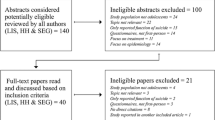Abstract
The present study examines reasons for adolescent deliberate self-harm. A cross-sectional survey using an anonymous self-report questionnaire was carried out in seven countries (Australia, Belgium, England, Hungary, Ireland, the Netherlands and Norway). Data on 30,477 school pupils between the ages of 14–17 were analysed. Past year and lifetime deliberate self-harm were assessed, along with the self-reported reasons for deliberate self-harm. The results showed that ‘wanted to get relief from a terrible state of mind’ and ‘wanted to die’ were most commonly reported. Principal component analysis indicated two underlying dimensions in the reasons for deliberate self-harm, i.e. a cry of pain motive and/or a cry for help motive. The majority of self-harmers reported at least one cry of pain motive (‘to die’, ‘to punish myself’, and ‘to get relief from a terrible state of mind’) and an additional cry for help motive (‘to show how desperate I was feeling’, to frighten someone’, ‘to get my own back on someone’, ‘to find out whether someone really loved me’, and ‘to get some attention’). Females reported more reasons than males. Only females showed an age difference, with girls aged 16–17 more frequently reporting a cry for help motive. There was considerable consistency in choice of motives across countries and genders. Systematic assessment of the reasons for deliberate self-harm can help clinicians to better understand the meaning of self harming behaviour, select appropriate treatment, suggest alternative coping strategies, and hopefully prevent future suicidal behaviour.
Similar content being viewed by others
References
Bancroft J, Hawton K, Simkin S, Kingston B, Cumming C, Whitwell D (1979) The reasons people give for taking overdoses: a further inquiry. Br J Med Psychol 52:353–365
Bancroft J, Skrimshire A, Simkin S (1976) The reasons people give for taking overdoses. Br J Psychiatry 128:538–548
Boergers J, Spirito A, Donaldson D (1998) Reasons for adolescent suicide attempts: associations with psychological functioning. J Am Acad Child Adolesc Psychiatry 37:1287–1293
Choquet M, Ledoux, S (1994) Adolescents—Enquête Nationale. Analyses et Perspectives. Paris: Inserm, 346 p
Hawton K, James A (2005) ABC of adolescence–suicide and deliberate self-harm in young people. Br Med J 330:891–894
Hawton K, Rodham K (2006) By their own young hand–deliberate self-harm and suicidal ideas in adolescents. Jessica Kingsley Publishers, London
Hawton K, Fagg J, Simkin S (1996) Deliberate self-poisoning and self-injury in children and adolescents under 16 years of age in Oxford, 1976–1993. Br J Psychiatry 169:202–208
Hawton K, Cole D, O’Grady J, Osborn M (1982) Motivational aspects of deliberate self poisoning in adolescents. Br J Psychiatry 141:286–291
Hawton K, Rodham K, Evans E, Weatherall R (2002) Deliberate self harm in adolescents: self report survey in schools in England. Br Med J 325:1207–1211
Hjelmeland H, Hawton K, Nordvik H, Bille-Brahe U, De Leo D, Fekete S, Grad O, Haring C, Kerkhof JF, Lonnqvist J, Michel K, Renberg ES, Schmidtke A, van Heeringen K, Wasserman D (2002) Why people engage in parasuicide: a cross-cultural study of intentions. Suicide Life Threat Behav 32:380–393
Holden R, Delisle M (2006) Factor structure of the reasons for attempting suicide questionnaire (RASQ) with suicide attempters. J Psychopathol Behav Assess 28:1–8
Holden R, Mcleod L (2000) The structure of the reasons for attempting suicide questionnaire (RASQ) in a nonclinical adult population. Personality Individ Differ 29:621–628
Holden R, Kerr P, Mendonca J, Velamoor V (1998) Are some motives more linked to suicide proneness than others? J Clin Psychol 54:569–576
Kalafat J, Elias M (1994) An evaluation of a school-based suicide awareness intervention. Suicide Life Threat Behav 24:224–233
Kerkhof A, Bernasco W, Bille-Brahe U, Platt S, Schmidtke A (1993) European parasuicide study interview schedule, initial interview. In: Bille-Brahe U (ed) WHO/EURO multicentre study on parasuicide. WHO Regional Office for Europe, Copenhagen
Kienhorst I, De Wilde E, Diekstra R, Wolters W (1995) Adolescents’ image of their suicide attempt. J Am Acad Child Adolesc Psychiatry 34:623–628
Madge N, Hewitt A, Hawton K, De Wilde EJ, Corcoran P, Fekete S, Van Heeringen K, De Leo D, Ystgaard M (2008) Deliberate self-harm within an international community sample of young people: comparative findings from the child and adolescent self-harm in Europe (CASE) study. J Child Psychol Psychiatry 49:667–677
Michel K, Valach L, Waeber V (1994) Understanding deliberate self-harm: the patients’ views. Crisis 15:172–178
Pagès F, Arvers P, Hassler C, Choquet M (2004) What are the characteristics of adolescent hospitalized suicide attempters? Eur Child Adolesc Psychiatry 13:151–158
Pollock L, Williams J (2001) Effective problem solving in suicide attempters depends on specific autobiographical recall. Suicide Life Threat Behav 31(4):386–396
Rodham K, Hawton K, Evans E (2004) Reasons for deliberate self-harm: comparison of self-poisoners and self-cutters in a community sample of adolescents. J Am Child Adolesc Psychiatry 43:1–8
Schnyder U, Valach L, Bichsel K, Michel K (1999) Attempted suicide—do we understand the patients’ reasons? Gen Hosp Psychiatry 21:62–69
Skögman K, öjehagen A (2003) Motives for suicide attempts—the views of the patients. Arch Suicide Res 7:193–206
Varadaraj R, Mendonca J, Rauchenberg P (1986) Motives and intent: a comparison of views of overdose patients and their key relatives/friends. Canad J Psychiatry 31:621–624
Williams J (2001) Suicide and attempted suicide. Understanding the cry of pain, Penguin
Ystgaard M, Arensman E, Hawton K, Madge N, Van Heeringen K, De Wilde EJ, De Leo D, Fekete S(2008) Deliberate self harm in adolescents: comparison between those who attend health services following self-harm and those who do not. Accepted by the J Adolesc
Author information
Authors and Affiliations
Corresponding author
Rights and permissions
About this article
Cite this article
Scoliers, G., Portzky, G., Madge, N. et al. Reasons for adolescent deliberate self-harm: a cry of pain and/or a cry for help?. Soc Psychiat Epidemiol 44, 601–607 (2009). https://doi.org/10.1007/s00127-008-0469-z
Received:
Revised:
Published:
Issue Date:
DOI: https://doi.org/10.1007/s00127-008-0469-z




